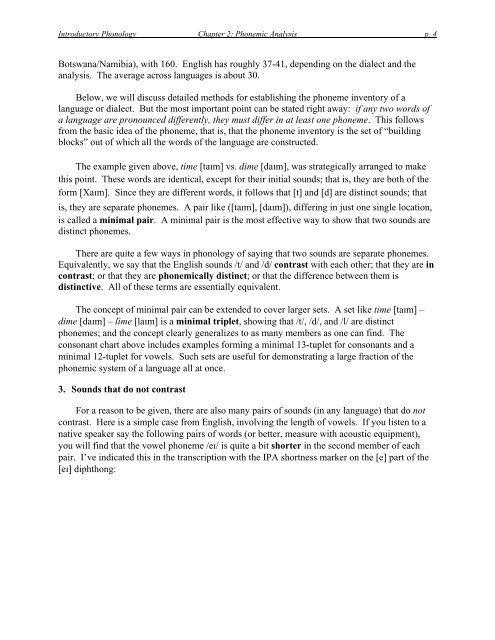Introductory Phonology - UCLA Department of Linguistics
Introductory Phonology - UCLA Department of Linguistics
Introductory Phonology - UCLA Department of Linguistics
You also want an ePaper? Increase the reach of your titles
YUMPU automatically turns print PDFs into web optimized ePapers that Google loves.
<strong>Introductory</strong> <strong>Phonology</strong> Chapter 2: Phonemic Analysis p. 4<br />
Botswana/Namibia), with 160. English has roughly 37-41, depending on the dialect and the<br />
analysis. The average across languages is about 30.<br />
Below, we will discuss detailed methods for establishing the phoneme inventory <strong>of</strong> a<br />
language or dialect. But the most important point can be stated right away: if any two words <strong>of</strong><br />
a language are pronounced differently, they must differ in at least one phoneme. This follows<br />
from the basic idea <strong>of</strong> the phoneme, that is, that the phoneme inventory is the set <strong>of</strong> “building<br />
blocks” out <strong>of</strong> which all the words <strong>of</strong> the language are constructed.<br />
The example given above, time [taɪm] vs. dime [daɪm], was strategically arranged to make<br />
this point. These words are identical, except for their initial sounds; that is, they are both <strong>of</strong> the<br />
form [Xaɪm]. Since they are different words, it follows that [t] and [d] are distinct sounds; that<br />
is, they are separate phonemes. A pair like ([taɪm], [daɪm]), differing in just one single location,<br />
is called a minimal pair. A minimal pair is the most effective way to show that two sounds are<br />
distinct phonemes.<br />
There are quite a few ways in phonology <strong>of</strong> saying that two sounds are separate phonemes.<br />
Equivalently, we say that the English sounds /t/ and /d/ contrast with each other; that they are in<br />
contrast; or that they are phonemically distinct; or that the difference between them is<br />
distinctive. All <strong>of</strong> these terms are essentially equivalent.<br />
The concept <strong>of</strong> minimal pair can be extended to cover larger sets. A set like time [taɪm] –<br />
dime [daɪm] – lime [laɪm] is a minimal triplet, showing that /t/, /d/, and /l/ are distinct<br />
phonemes; and the concept clearly generalizes to as many members as one can find. The<br />
consonant chart above includes examples forming a minimal 13-tuplet for consonants and a<br />
minimal 12-tuplet for vowels. Such sets are useful for demonstrating a large fraction <strong>of</strong> the<br />
phonemic system <strong>of</strong> a language all at once.<br />
3. Sounds that do not contrast<br />
For a reason to be given, there are also many pairs <strong>of</strong> sounds (in any language) that do not<br />
contrast. Here is a simple case from English, involving the length <strong>of</strong> vowels. If you listen to a<br />
native speaker say the following pairs <strong>of</strong> words (or better, measure with acoustic equipment),<br />
you will find that the vowel phoneme /eɪ/ is quite a bit shorter in the second member <strong>of</strong> each<br />
pair. I’ve indicated this in the transcription with the IPA shortness marker on the [e] part <strong>of</strong> the<br />
[eɪ] diphthong:

















